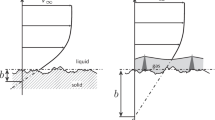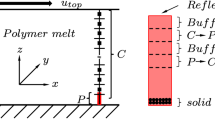Abstract
A theoretical model extended from the Frenkel-Eyring molecular kinetic theory (MKT) was applied to describe the boundary slip on textured surfaces. The concept of the equivalent depth of potential well was adopted to characterize the solid-liquid interactions on the textured surfaces. The slip behaviors on both chemically and topographically textured surfaces were investigated using molecular dynamics (MD) simulations. The extended MKT slip model is validated by our MD simulations under various situations, by constructing different complex surfaces and varying the surface wettability as well as the shear stress exerted on the liquid. This slip model can provide more comprehensive understanding of the liquid flow on atomic scale by considering the influence of the solid-liquid interactions and the applied shear stress on the nano-flow. Moreover, the slip velocity shear-rate dependence can be predicted using this slip model, since the nonlinear increase of the slip velocity under high shear stress can be approximated by a hyperbolic sine function.
Similar content being viewed by others
References
Gogte S, Vorobieff P, Truesdell R, et al. Effective slip on textured superhydrophobic surfaces. Phys Fluids, 2005, 17: 051701
Barthlott W, Neinhuis C. Purity of sacred lotus, or escape from contamination in biological surfaces. Planta, 1997, 202: 1–8
Frohnapfel B, Jovanović J, Delgado A. Experimental investigations of turbulent drag reduction by surface-embedded grooves. J Fluid Mech, 2007, 590: 107–116
Bechert D W, Bruse M, Hage W, et al. Experiments on drag-reducing surfaces and their optimization with an adjustable geometry. J Fluid Mech, 1997, 338: 59–87
Tu Y S, Xiu P, Wan R Z, et al. Water-mediated signal multiplication with y-shaped carbon nanotubes. Proc Natl Acad Sci USA, 2009, 106: 18120–18124
Xiu P, Zhou B, Qi W P, et al. Manipulating biomolecules with aqueous liquids confined within single-walled nanotubes. J Am Chem Soc, 2009, 131: 2840–2845
Zhao Y P. Physical Mechanics of Surfaces and Interfaces. Beijing: Science Press, 2012
Zhao Y P. Moving contact line problem: Advances and perspectives. Theor Appl Mech Lett, 2014, 4: 034002
Neto C, Evans D R, Bonaccurso E, et al. Boundary slip in newtonian liquids: A review of experimental studies. Rep Prog Phys, 2005, 68: 2859–2897
Truesdell R, Mammoli A, Vorobieff P, et al. Drag reduction on a patterned superhydrophobic surface. Phys Rev Lett, 2006, 97: 044504
Mongruel A, Chastel T, Asmolov E S, et al. Effective hydrodynamic boundary conditions for microtextured surfaces. Phys Rev E, 2013, 87: 011002
Yuan Q Z, Zhao Y P. Multiscale dynamic wetting of a droplet on a lyophilic pillar-arrayed surface. J Fluid Mech, 2013, 716: 171–188
Wu C M, Lei S L, Qian T Z, et al. Stick-slip motion of moving contact line on chemically patterned surfaces. Commun Comput Phys, 2010, 7: 403–422
Capozza R, Fasolino A, Ferrario M, et al. Lubricated friction on nanopatterned surfaces via molecular dynamics simulations. Phys Rev B, 2008, 77: 235432
Priezjev N V, Darhuber A A, Troian S M. Slip behavior in liquid films on surfaces of patterned wettability: Comparison between continuum and molecular dynamics simulations. Phys Rev E, 2005, 71: 041608
Priezjev N V. Effect of surface roughness on rate-dependent slip in simple fluids. J Chem Phys, 2007, 127: 144708
Priezjev N V. Molecular diffusion and slip boundary conditions at smooth surfaces with periodic and random nanoscale textures. J Chem Phys, 2011, 135: 204704
Tretyakov N, Müller M. Correlation between surface topography and slippage: A molecular dynamics study. Soft Matter, 2013, 9: 3613–3623
Wang X P, Qian T Z, Sheng P. Moving contact line on chemically patterned surfaces. J Fluid Mech, 2008, 605: 59–78
Huang D M, Sendner C, Horinek D, et al. Water slippage versus contact angle: A quasiuniversal relationship. Phys Rev Lett, 2008, 101: 226101
Patankar N A. On the modeling of hydrophobic contact angles on rough surfaces. Langmuir, 2003, 19: 1249–1253
Thompson P A, Troian S M. A general boundary condition for liquid flow at solid surfaces. Nature, 1997, 389: 360–362
Ma M D, Shen L M, Sheridan J, et al. Friction of water slipping in carbon nanotubes. Phys Rev E, 2011, 83: 036316
Vinogradova O I. Drainage of a thin liquid film confined between hydrophobic surfaces. Langmuir, 1995, 11: 2213–2220
Wei N, Peng X S, Xu Z P. Breakdown of fast water transport in graphene oxides. Phys Rev E, 2014, 89: 012113
Ho T A, Papavassiliou D V, Lee L L, et al. Liquid water can slip on a hydrophilic surface. Proc Natl Acad Sci USA, 2011, 108: 16170–16175
Wang F C, Zhao Y P. Slip boundary conditions based on molecular kinetic theory: The critical shear stress and the energy dissipation at the liquid-solid interface. Soft Matter, 2011, 7: 8628–8634
Philip J R. Flows satisfying mixed no-slip and no-shear conditions. Z Angew Math Phys, 1972, 23: 353–372
Philip J R. Integral properties of flows satisfying mixed no-slip and no-shear conditions. Z Angew Math Phys, 1972, 23: 960–968
Lauga E, Stone H A. Effective slip in pressure-driven stokes flow. J Fluid Mech, 2003, 489: 55–77
Yang F Q. Slip boundary condition for viscous flow over solid surfaces. Chem Eng Comm, 2010, 197: 544–550
Frenkel J I. Kinetic Theory of Liquids. Oxford: Oxford University Press, 1946
Glasstone S, Laidler K J, Eyring H. The Theory of Rate Processes. New York: McGraw-Hill, 1941
Blake T D, Haynes J M. Kinetics of liquid/liquid displacement. J Colloid Interface Sci, 1969, 30: 421–423
Blake T D. The physics of moving wetting lines. J Colloid Interface Sci, 2006, 299: 1–13
Yuan Q Z, Zhao Y P. Precursor film in dynamic wetting, electrowetting, and electro-elasto-capillarity. Phys Rev Lett, 2010, 104: 246101
Zhu X Y, Yuan Q Z, Zhao Y P. Capillary wave propagation during the delamination of graphene by the precursor films in electro-elasto- capillarity. Sci Rep, 2012, 2: 927
Wang F C, Zhao Y P. Contact angle hysteresis at the nanoscale: A molecular dynamics simulation study. Colloid Polym Sci, 2013, 291: 307–315
Yang F Q. Diffusion-induced stress in inhomogeneous materials: concentration-dependent elastic modulus. Sci China-Phys Mech Astron, 2012, 55(6): 955–962
Humphrey W, Dalke A, Schulten K. VMD: Visual molecular dynamics. J Mol Graphics, 1996, 14: 33–38
Berendsen H J C, Grigera J R, Straatsma T P. The missing term in effective pair potentials. J Phys Chem, 1987, 91: 6269–6271
Hockney R W, Eastwood J W. Computer Simulation Using Particles. New York: Adam Hilger, 1988
Plimpton S. Fast parallel algorithms for short-range molecular dynamics. J Comput Phys, 1995, 117: 1–19
Yeh I C, Berkowitz M L. Ewald summation for systems with slab geometry. J Chem Phys, 1999, 111: 3155–3162
Martini A, Hsu H Y, Panankar N A, et al. Slip at high shear rates. Phys Rev Lett, 2008, 100: 206001
McBride S P, Law B M. Viscosity-dependent liquid slip at molecularly smooth hydrophobic surfaces. Phys Rev E, 2009, 80: 060601
Kannam S K, Todd B D, Hansen J S, et al. Slip length of water on graphene: Limitations of non-equilibrium molecular dynamics simulations. J Chem Phys, 2012, 136: 024705
Lichter S, Roxin A, Mandre S. Mechanisms for liquid slip at solid surfaces. Phys Rev Lett, 2004, 93: 086001
Yong X, Zhang L T. Thermostats and thermostat strategies for molecular dynamics simulations of nanofluidics. J Chem Phys, 2013, 138: 084503
Yong X, Zhang L T. Slip in nanoscale shear flow: Mechanisms of interfacial friction. Microfluid Nanofluid, 2013, 14: 299–308
Yuan Q Z, Zhao Y P. Topology-dominated dynamic wetting of the precursor chain in a hydrophilic interior corner. Proc R Soc A, 2012, 468: 310–322
Sun Z W, Xu S H. Two examples of using physical mechanics approach to evaluate colloidal stability. Sci China-Phys Mech Astron, 2012, 55(6): 933–939
Yu Y, Wu Q, Zhang K, et al. Effect of triple-phase contact line on contact angle hysteresis. Sci China-Phys Mech Astron, 2012, 55(6): 1045–1050
Wang X W, Yu Y. Analysis of the shape of heavy droplets on flat and spherical surface. Sci China-Phys Mech Astron, 2012, 55(6): 1118–1124
Zhang W L, Qian J, Yao H M, et al. Effects of functionally graded materials on dynamics of molecular bond clusters. Sci China-Phys Mech Astron, 2012, 55(6): 980–988
Joseph S, Aluru N R. Why are carbon nanotubes fast transporters of water? Nano Lett, 2008, 8: 452–458
Cottin-Bizonne C, Barentin C, Charlaix E, et al. Dynamics of simple liquids at heterogeneous surfaces: Molecular-dynamics simulations and hydrodynamic description. Eur Phys J E, 2004, 15: 427–438
Wenzel R N. Resistance of solid surfaces to wetting by water. Ind Eng Chem, 1936, 28: 988–994
Cassie A B D, Baxter S. Wettability of porous surfaces. Trans Faraday Soc, 1944, 40: 546–551
Author information
Authors and Affiliations
Corresponding authors
Additional information
Contributed by ZHAO YaPu (Associate Editor)
Rights and permissions
About this article
Cite this article
Wang, L., Wang, F., Yang, F. et al. Molecular kinetic theory of boundary slip on textured surfaces by molecular dynamics simulations. Sci. China Phys. Mech. Astron. 57, 2152–2160 (2014). https://doi.org/10.1007/s11433-014-5586-y
Received:
Accepted:
Published:
Issue Date:
DOI: https://doi.org/10.1007/s11433-014-5586-y




